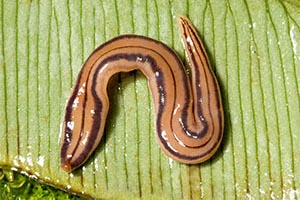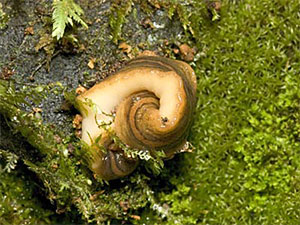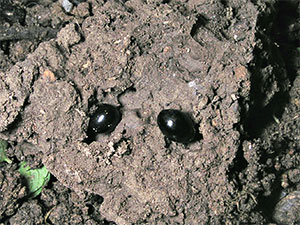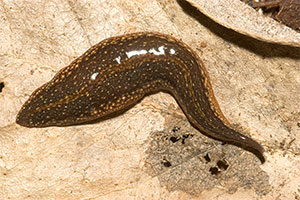|
Turbellaria

Undescribed native flatworm ( "Australopacifica")
from New Zealand.
Common name: terrestrial flatworms, land planarians, Maori toke.
Scienific name: phylum Platyhelminthes — “flat worms”, class Turbellaria, order Seriata, infraorder Terricola.
Description
The flatworms (Turbellaria) are mostly marine, some inhabit fresh water, and the members of Terricola (terrestrial flatworms) live in moist terrestrial habitats. Terrestrial flatworms can be mistaken for slugs, but as the name suggests, the flatworms are more flattened dorso-ventrally.
Terrestrial flatworms are free-living soil
animals, 0.5-10 cm in length, with flattened and unsegmented
bodies. The size of a flatworm is not constant, as these
animals can stretch out or contract considerably, changing
shape as they move. Typically, the body is elongated, with
narrower anterior and posterior ends. Eye spots may be present,
but often are absent or very small, so that the head and tail
ends of a flatworm are not easily identified if it is not
moving. The movement is by a gliding motion, and a thin mucous
trail is left behind the worm as it moves. The New Zealand flatworms
are often colourful, with spots and stripes or in solid colours,
in many shades of reddish-brown, purple, whitish, and black.
Bodies of flatworms are usually very fragile, easily damaged
by a slightest touch, and collected worms die and decompose
quickly.
Notes on biology

Terrestrial flatworm (undescribed genus), North Island,
New Zealand.
Terrestrial flatworms are predators that attack a range of small animals including slugs, snails, earthworms, and other soil invertebrates. Flatworms hunt actively in the soil, moving along crevices and burrows, as they follow the scented trail of their prey. The mouth of a flatworm is not on its anterior (head) end, but half-way down the length of the body, in the centre of the ventral surface. Multiple mouths can be present. The worm feeds by attaching itself to its prey with mucus, secreting digestive juices, and digesting the prey externally. Small prey animals can be swallowed whole. When food is not available, flatworms appear to be able to survive for over a year without feeding. Many terrestrial flatworms feed on earthworms, attacking and successfully feeding on earthworms up to 55 times larger than themselves (Zaborski, 2002).
One New Zealand flatworm Arthurdendyus triangulatus (Artioposthia triangulata), an earthworm-feeding species, has become a dreaded invasive species in Europe. This voracious carnivorous flatworm was accidentally introduced into parts of Northern Ireland, Scotland, and a few other places in the 1970s, and now causes serious problems in the soil by wiping out local earthworm populations. Arthurdendyus triangulatus has no preferred prey, but will eat any species of earthworm that it can find, at a rate of approximately one earthworm a week.

This flatworm has tied itself into a knot. |

Egg cocoons of a terrestrial flatworm. |
The skin of terrestrial flatworms is full
of mucus glands, which secrete an abundant supply of mucus. The flatworms
are slimy and very sticky, and leave behind mucus trail as
they move. To protect itself from dessication, a flatworm
can virtually tie itself into a knot, reducing the body surface
exposed to the air. The thin layer of mucus envelops the knotted
body, forming a protective cocoon. This mucus cocoon is easily
broken once the worm decides to move.
The flatworm lays eggs protected by capsules
or cocoons, the eggs hatch as miniature worms. Terrestrial
flatworms are well known for their remarkable regeneration
abilities, and some flatworms successfully reproduce by dividing
into fragments. Each fragment then regenerates missing organs.
Where to find them?
 Newzelandia
Newzelandia sp., an endemic NZ flatworm.
Flatworms are very vulnerable to desiccation, so they are normally found in damp shady places — under logs and stones in native forests, in soil or under leaf litter. During the day, flatworms find refuge in damp places, but at night they can be seen in the open in habitats with high humidity, such as on the stones along forest stream beds or on the surface of moist soil. In and around human environments flatworms are often found under bricks, paving tiles, pieces of wood, or in folds of black garden plastic, in greenhouses, gardens, and plant nurseries. When looking for flatworms, place overturned logs and stones back into their original position — it will preserve the habitat for the flatworms and many other species.
Flatworms are active and colourful when
observed live. Collecting and preserving flatworms is a difficult
task and I don’t recommend it for a non-specialist.
Their bodies are easily damaged when handled, and they are
very sensitive to heat and dessication; captured flatworms
may die quickly and decompose within hours. When fixed in
alcohol, flatworms lose their shape and colours, so identification
is based on the internal anatomy.
Distribution and conservation
Flatworms are found throughout New Zealand,
but their diversity, fauna, and distribution are still poorly
known. More than 100 different species of terrestrial flatworms
are expected to exist in New Zealand, but most species are
undescribed, and little is known about their distribution,
ecology, or impact on other invertebrates. Artioposthia mariae,
a flatworm recorded from Golden Bay and Motueka in the South Island
has been listed as a protected species by the NZ Department
of Conservation, but the threats and conservation status for
this species are unknown.
Worldwide, distributions of terrestrial
flatworms have been extended significantly by humans, as flatworms
are easily spread via the trade of potted plants. The “New
Zealand flatworm” Arthurdendyus triangulatus
and other Australasian species are now found in the British
Isles and Faroe Islands. In return, exotic species have become
established in New Zealand. Terrestrial flatworms are fascinating
organisms; because of their potential for human-mediated spread,
more data on their natural distribution and biology is required.
Included images:
- Order Seriata
- Family Geoplanidae
- Arthurdendyus
(=Artioposthia) testaceus (Hutton, 1880) - Palmerston
North, WI, North Island (2 images)
- Arthurdendyus
(=Artioposthia) sp. undescribed - Canaan Road
near Harwood Hole, NN, South Island (2 images)
- Arthurdendyus
(=Artioposthia)? sp. - Peel Forest, Dennistoun
Bush, SC, South Island (3 images)
- Arthurdendyus
triangulatus (Dendy, 1894) - Temple Valley,
Lake Ohau, MK, South Island
- Arthurdendyus
triangulatus (Dendy, 1894)
- Temple Valley, Lake Ohau, MK, South Island
- 'Australoplana'
sp. undescribed - Nelson, NN, South Island
- Australopacifica
maori - Craigieburn Forest Park, Broken River
Road, Jacks Pass, NC, South Island (2 images)
- Australopacifica
nr. suteri (Dendy, 1897) - Kaiteriteri Road,
NN, South Island
- 'Australopacifica'
sp. - Craigieburn Forest Park, Lyndon Hutt, NC, South
Island (2 images)
- Australopacifica
sp. undescribed - Ohinetonga Scenic Reserve,
TO, North Island (3 images)
- Kontikia
sp. - Palmerston North, WI, North Island
- Newzealandia
sp. undescribed - Palmerston North, WI, North Island
(2 images)
- Newzealandia
sp. undescribed - Palmerston North, WI, North Island
(2 images)
- 'Australopacifica'
sp. - Torlesse Range, Porters Pass, NC, South
Island (2 images)
- Newzealandia
sp. undescribed - Rimu Valley Walk, SD, South Island
- Artioposthia
exulans (Dendy, 1901) - Kawhatau Base, RI, North
Island
- Newzealandia
nr. moseleyi (Hutton, 1880) - Peel Forest, Dennistoun
Bush, SC, South Island (2 images)
- 'Australopacifica'- Hawdon Valley, NC, South Island
- 'Australopacifica'
species - Ohinetonga, TO, North Island
- 'Australopacifica'
species - Peel Forest Park, Dennistoun Bush, SC,
South Island (2 images)
- 'Australopacifica'
species - Peel Forest Park, Dennistoun Bush, SC,
South Island (3 images)
- 'Australopacifica'
species - Katikara Stream, Taranaki, TK, North
Island
- 'Australopacifica'
species - Katikara Stream, Taranaki, TK, North Island
(3 images)
- 'Australopacifica'
species - Katikara Stream, Taranaki, TK, North Island
(2 images)
- Flatworm egg capsules - Palmerston North, WI, North Island
Further information on New Zealand
terrestrial flatworms:
Cannon L.R.G. 1986. Turbellaria of the World
- a Guide to Families and Genera. Queensland Museum, Southern
Brisbane, Australia. 136 p.
Johns P.M., Boag B. 2003. The spread and
distribution of terrestrial planarians (Turbellaria: Tricladida:
Geoplanidae) within New Zealand. New Zealand Journal of Ecology
27, p. 201-206.
Johns P.M., Boag B., Yeates G.W. 1998.
Observations on the geographic distribution of flatworms (Turbellaria
: Rhynchodemidae, Bipaliidae, Geoplanidae) in New Zealand.
Pedobiologia 42, p. 469-476.
Yeates G.W. (Ed.) 1998. OECD Workshop on
Terrestrial Flatworms. New Zealand, 1998. Pedobiologia 42,
199 p.
Sluys R. 1999. Global diversity of land
planarians (Platyhelminthes, Tricladida, Terricola): a new
indicator-taxon in biodiversity and conservation studies.
Biodiversity and Conservation 8, p. 1663-1681.
Winsor L, Stevens M.I. 2005. Terrestrial
flatworms (Platyhelminthes:
Tricladida: Terricola) from sub-Antarctic Macquarie Island.
Kanunnah 1, p. 17-32.
Turbellaria Resources on the Web
Terrestrial
Flatworms, by Andrew Fraser, some information on terrstrial
flatworms in Britain.
Flatworms,
Landcare Research, New Zealand, brief description.
Fauna
Europaea: Terricola, taxonomy of Terricola and checklist
of European species.
Checklist
of the Italian fauna on-line, checklist of Italian Turbellaria.
|